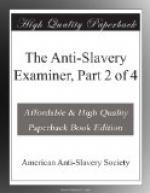In 1785, the New York Manumission Society was formed. John Jay was chosen its first President, and held the office five years. Alexander Hamilton was its second President, and after holding the office one year, resigned upon his removal to Philadelphia as Secretary of the United States’ Treasury. In 1787, the Pennsylvania Abolition Society was formed. Benjamin Franklin, warm from the discussions of the convention that formed the U.S. constitution, was chosen President, and Benjamin Rush Secretary—both signers of the Declaration of Independence. In 1789, the Maryland Abolition Society was formed. Among its officers were Samuel Chase, Judge of the U.S. Supreme Court, and Luther Martin, a member of the convention that formed the U.S. constitution. In 1790, the Connecticut Abolition Society was formed. The first President was Rev. Dr. Stiles, President of Yale College, and the Secretary, Simeon Baldwin, (late Judge Baldwin of New Haven.) In 1791, this Society sent a memorial to Congress, from which the following is an extract:
“From a sober conviction of the unrighteousness of slavery, your petitioners have long beheld, with grief, our fellow men doomed to perpetual bondage, in a country which boasts of her freedom. Your petitioners were led, by motives, we conceive, of general philanthropy, to associate ourselves for the protection and assistance of this unfortunate part of our fellow men; and, though this Society has been lately established, it has now become generally extensive through this state, and, we fully believe, embraces, on this subject, the sentiments of a large majority of its citizens.”
The same year the Virginia Abolition Society was formed. This Society, and the Maryland Society, had auxiliaries in different parts of those States. Both societies sent up memorials to Congress. The memorial of the Virginia Society is headed—“The memorial of the Virginia Society, for promoting the Abolition of Slavery,” &c. The following is an extract:
“Your memorialists, fully believing that slavery is not only an odious degradation, but an outrageous violation of one of the most essential rights of human nature, and utterly repugnant to the precepts of the gospel,” &c.
About the same time a Society was formed in New-Jersey. It had an acting committee of five members in each county in the State. The following is an extract from the preamble to its constitution:
“It is our boast, that we live under a government, wherein life, liberty, and the pursuit of happiness, are recognized as the universal rights of men. We abhor that inconsistent, illiberal, and interested policy, which withholds those rights from an unfortunate and degraded class of our fellow creatures.”




